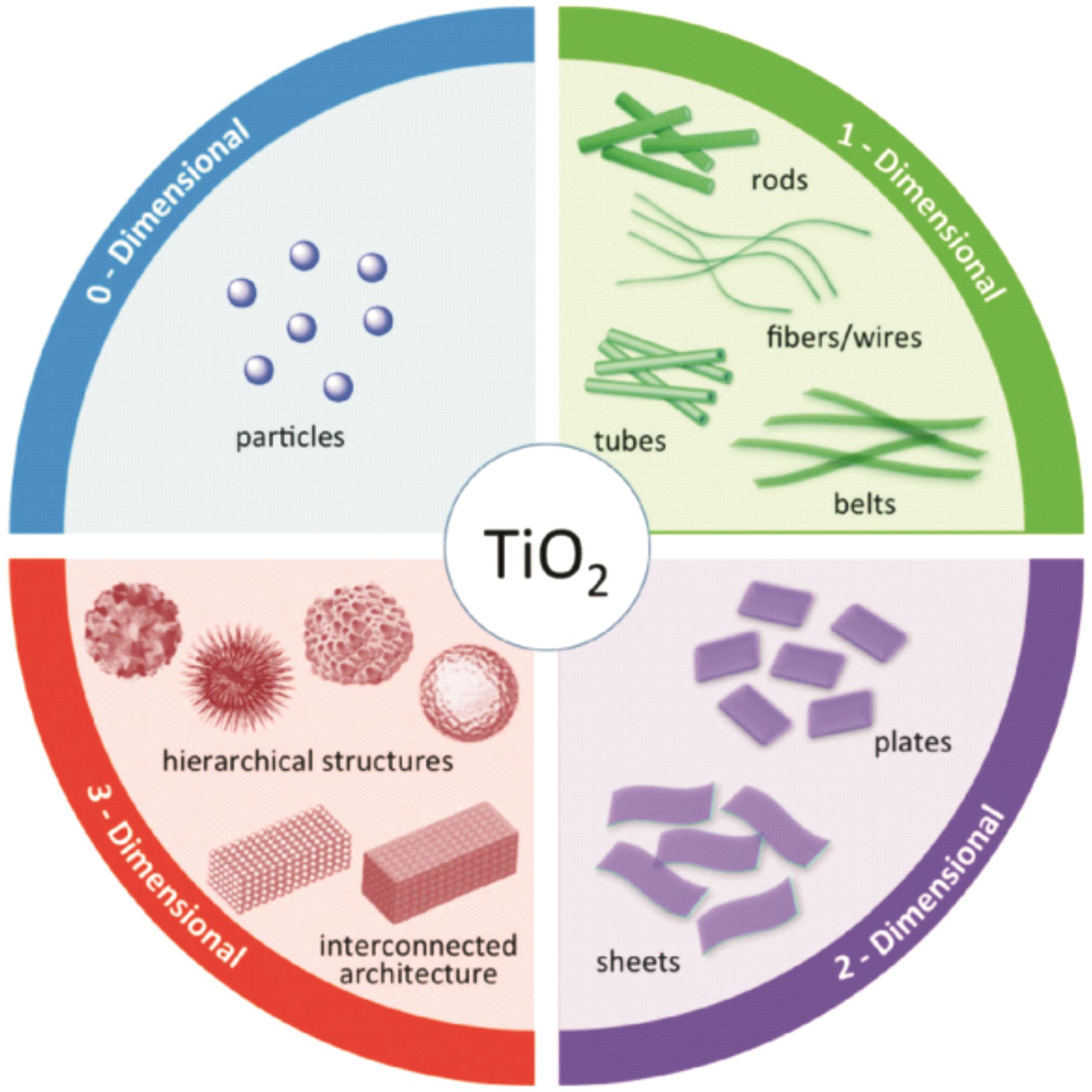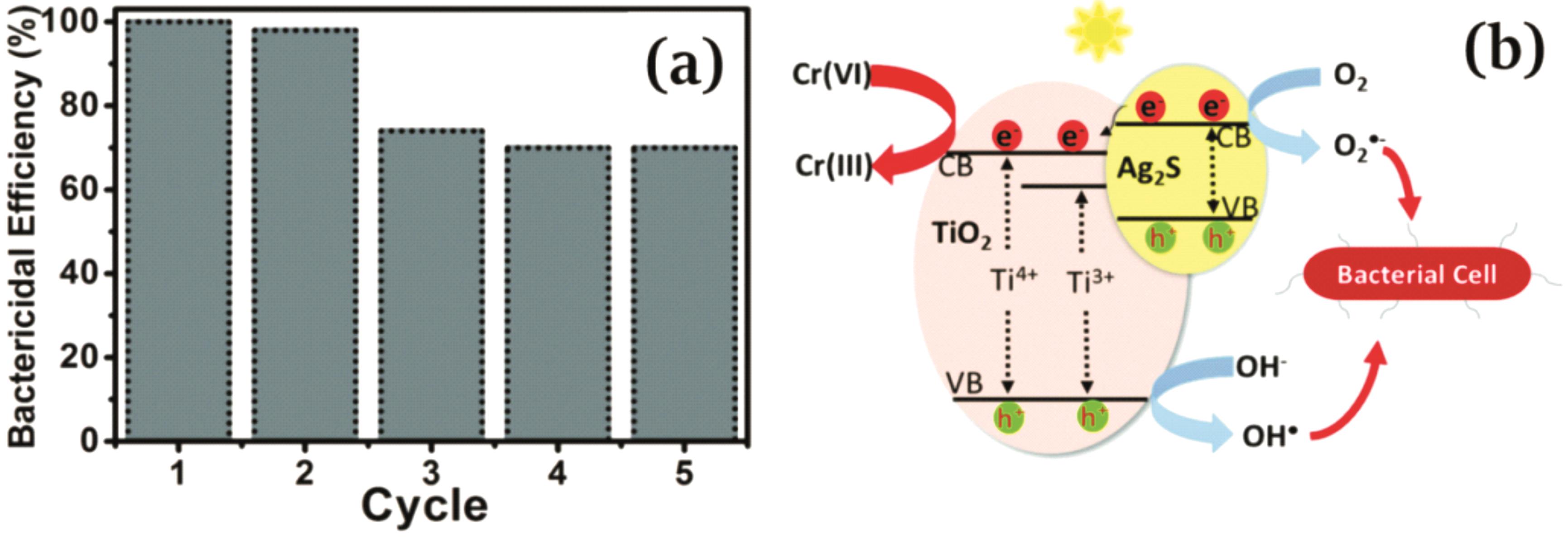
Chinese Journal of Applied Chemistry ›› 2022, Vol. 39 ›› Issue (4): 629-646.DOI: 10.19894/j.issn.1000-0518.210483
• Review • Previous Articles Next Articles
Research Progress on Photocatalytic Antibacterial Application of TiO2 Nano Materials
Jia-He WANG1, Da-Yong LIU1, Wei LIU1, Lin WANG2( ), Biao DONG1(
), Biao DONG1( )
)
- 1.College of Electronic Science and Engineering,Jilin University,State Key Laboratory of Integrated Optoelectronics,Changchun 130012,China
2.Hospital of Stomatology,Jilin University,Dental Implantation,Changchun 130021,China
-
Received:2021-09-28Accepted:2022-02-21Published:2022-04-01Online:2022-04-19 -
Contact:Lin WANG,Biao DONG -
Supported by:the National Natural Science Foundation of China(61775080);the Major Basic Research Projects of Shandong Natural Science Foundation(ZR2020ZD36)
CLC Number:
Cite this article
Jia-He WANG, Da-Yong LIU, Wei LIU, Lin WANG, Biao DONG. Research Progress on Photocatalytic Antibacterial Application of TiO2 Nano Materials[J]. Chinese Journal of Applied Chemistry, 2022, 39(4): 629-646.
share this article
Add to citation manager EndNote|Ris|BibTeX
URL: http://yyhx.ciac.jl.cn/EN/10.19894/j.issn.1000-0518.210483
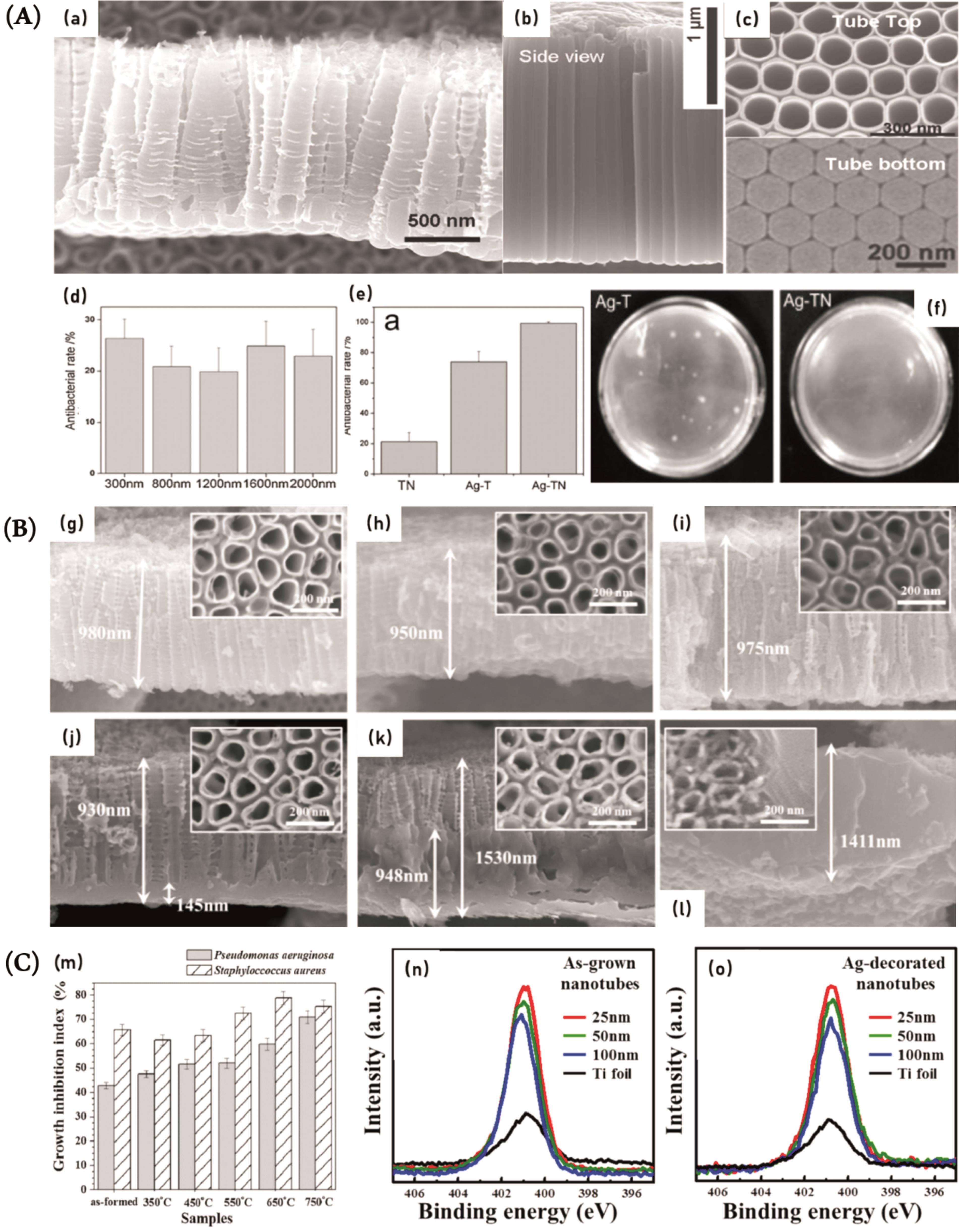
Fig.3 (A) Image of TiO2 one-dimensional nanotube antibacterial experiment results (a-c) SEM images of (a) first-generation titanium dioxide nanotube layer (short and side wall ripple) and (b)the latest generation of titanium dioxide nanotube layers (height to width ratio, highly ordered, smooth walls) show side view (c)top and bottom views (Panels b and c)[6]; (d-f) Figure d[7] shows the antibacterial rate of titanium nanotubes with different lengths and diameters of 100 nm, while Figure e and f show the antibacterial rate of different materials: Ag-T, Silver deposited flat titanium plate; Ag-TN, silver deposited titanium nanotubes, diameter 100 nm, length 800 nm; (B) (g-l) TiO2 cross section and top view (inset) SEM image of the astrologer nanotube: (g)Amorphous and degenerates at temperature: (h)350 ℃: (i)450 ℃: (j)550 ℃: (k)650 ℃: (l)750 ℃[8]; (C) (m)The growth inhibition indices of Pseudomonas aeruginosa and Staphylococcus aureus[8]; (n-o) XPS surface analysis results of N1s growth in the spectrum and silver decorated TiO2 nanotubes[9]
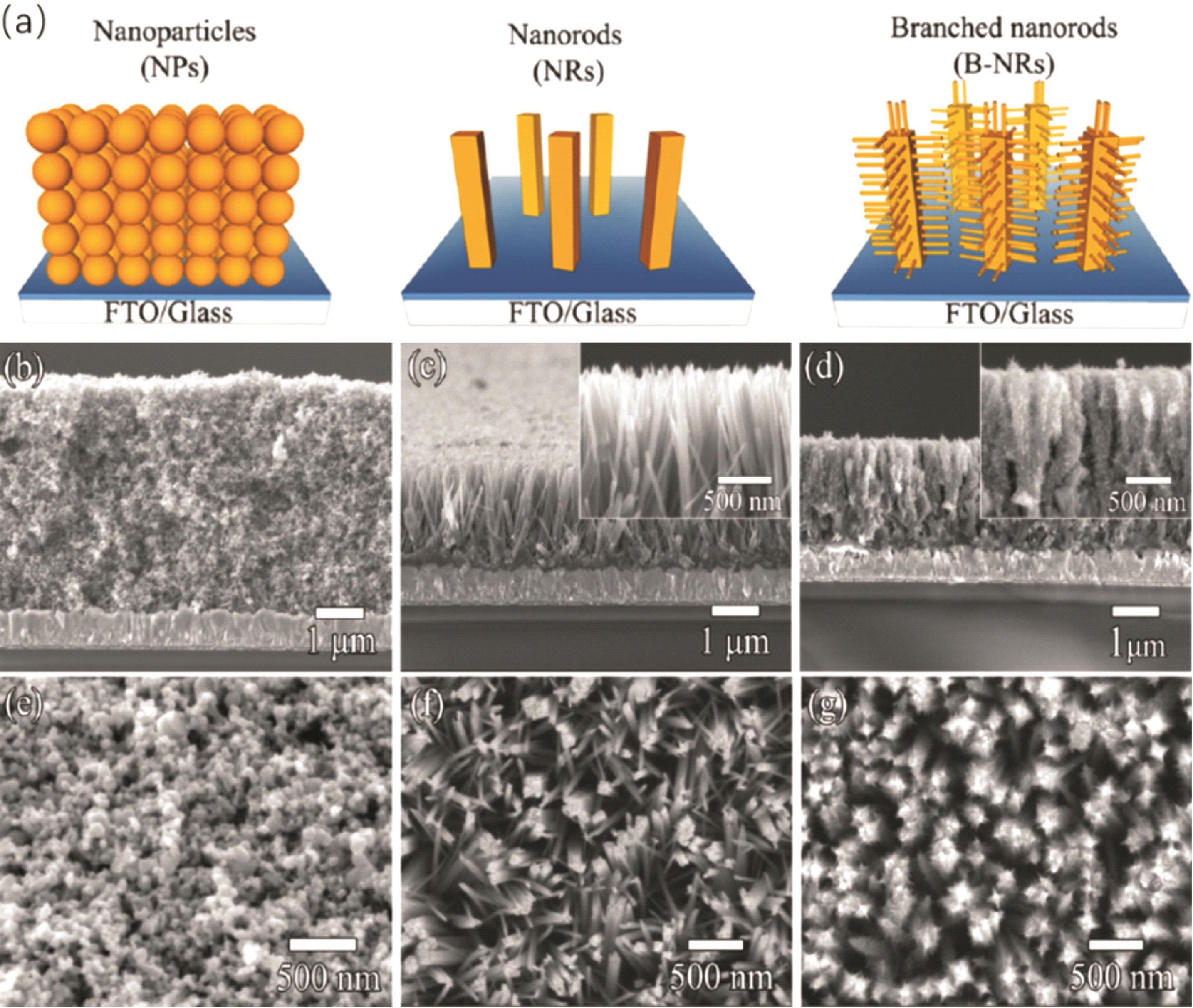
Fig.4 (a) NPs, NRs, B-NRS schematic description. (b, e) SEM image of nano-particles (NPs). (c, f) SEM image of nanorods (NRs). (d, g) SEM image of single crystal branched nanorods (B-NRS) [19]

Fig.5 Core-shell structure of TiO2 (a-p) TEM images of various TiO2-based core-shell nanocatalysts. (a) Core-shell structure; (b) Hollow structure; (c,d) Yolk shell structure; (e,f) Double hull structure. Nuclei of various shapes were also used, (g,h) nanoparticles; (i-l) nanorods; (m) nanocube; (n) More complex core-shell structures; (o,p) A multishell structure without an inner cavity[27]; (q-s) Antibacterial activity of samples under different light conditions: (q) c-Fe2O3@SiO2 @TiO2-Ag (r)TiO2 is contrasted (s) (Without catalyst)[28]; (t-u) The survival rate of (t) Escherichia coli and (u) Staphylococcus aureus on the surface of raw TiO2 and TiO2/poly[2-(tert-butylamino) ethyl methacrylate-copolymer ethylene glycol dimethacrylate] core/shell nanoparticles in relation to UV irradiation time (min)[29]
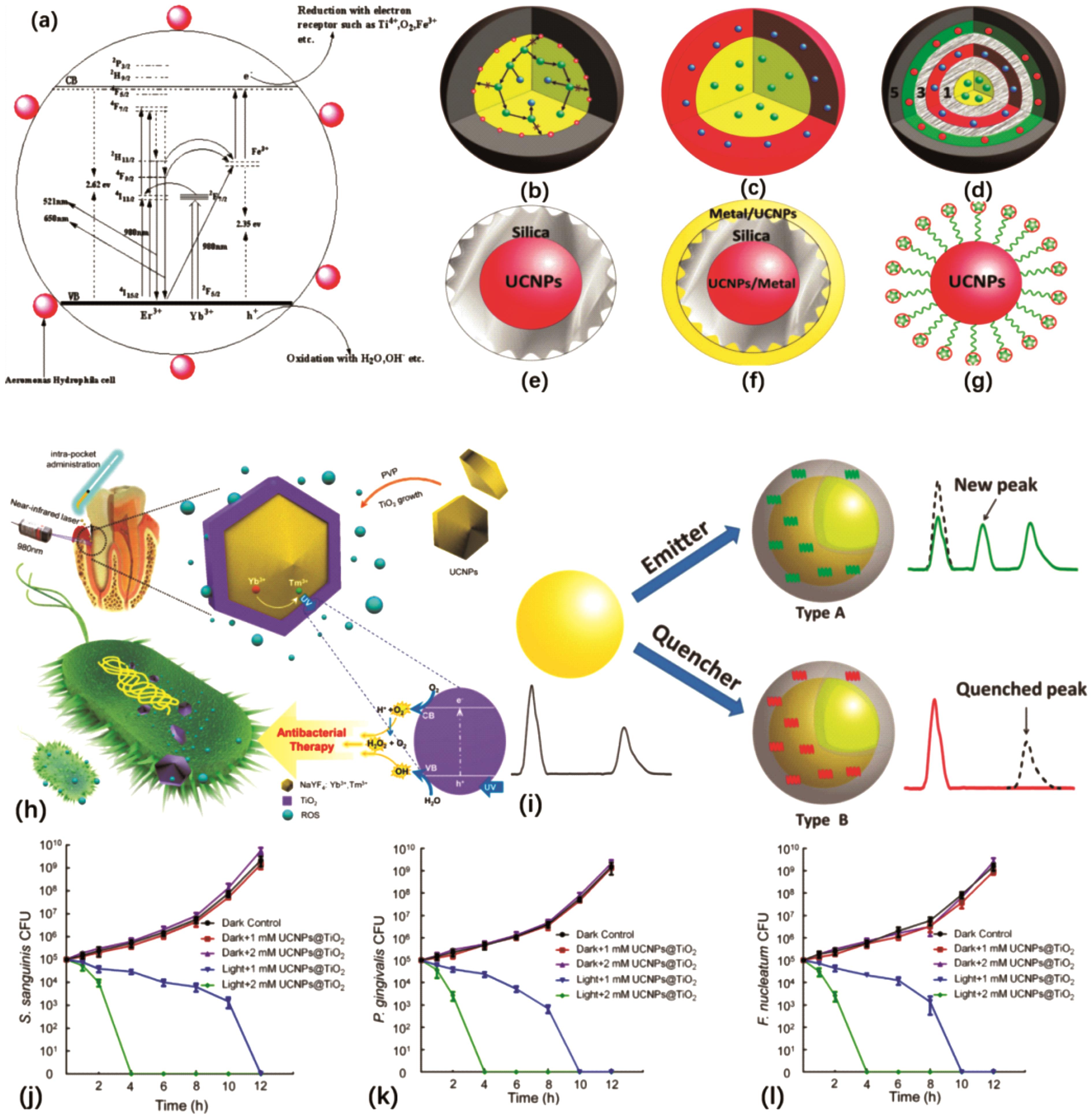
Fig.6 (a) Upconversion energy transfer mechanism[44]; (b-g) Different types of core-shell structures. (b) Core-shell UCNPs with “inert” (i.e., without any absorbing/emitting lanthanide doping) shells; The color spheres in the core region depict lanthanide dopants; The red circle on the interface represents the surface hardening part; Black arrows represent random energy transfer paths; (c) Core-shell UCNPs with active shells; (d) Core-shell UCNPs with multiple shells; (e) UCNPs@SiO2 core-shell nanoparticles; (f) Core-shell UCNPs@SiO2[48]; (h)Synthesis of NaYF4∶ Yb3+,Tm3+@TiO2 and the mechanism of aPDT NEAR infrared Radiation Under the near infrared radiation[47]. (i) schematic of upconversion luminescence tuned using a non-epitaxy UCNPs silica core-shell structure; (j-l) Time killing test of porphyromonasgingivalis and Layer fibriumnucleobacillus under UCNPs@TiO2 near infrared radiation[47]

Fig.7 (a) Curves of photocatalytic degradation ratio of RhB in Different concentrations of Fe3+[57]; (b) Antibacterial effect of TiO2 doped with Fe on Escherichia coli (■) Antifungal rate of bare TiO2, (●) 0.1%, (▲) 0.5%, (▼) 1.0%, (?) 2.0% and (?) 3.45% Fe doped TiO2 antifungal rate of Escherichia coli[58]. (c) The photocatalysis of CeO2 doped TiO2 nanocomposites was studied under hydrothermal condition of 700 ℃ in 9 h[51]

Fig.8 (a) Study on antibacterial mechanism of Ag NPs; (b) Schematic diagram of Au NPs promoting TiO2 photocatalytic activity in UV-visible light; (c) E.coli's CFU grows, at different times, in media, with the presence of low-light (■) and visible light (▲) and sunlight (●), as compared with a-TiO2, Ag/a-TiO2, Ag-TiO2/Ag/a-TiO2 and a-TiO2 blank (controlled) samples[59]; (d) Degradation curves of alginate solution and Au-TiO2 nanocomposites[63]
| 1 | YAMAWUCHI K, YAO Y, OCHIAI T, et al. Antibacterial activity of hydrophobic composite materials containing a visible-light-sensitive photocatalyst[J]. J Nanotechnol, 2016, 33(7): 1989-1998. |
| 2 | MATSUNAGA T, TOMODA R, NAKAJIMA T, et al. Photoelectrochemical sterilization of microbial cells by semiconductor powders[J]. FEMS Microbiol Lett, 1985, 29(1/2): 211-214. |
| 3 | GOGNIAT G, THYSSEN M, DENIS M, et al. The bactericidal effect of TiO2 photocatalysis involves adsorption onto catalyst and the loss of membrane integrity[J]. FEMS Microbiol Lett, 2006, 258(1): 18-24. |
| 4 | OGUMA, KATAYAMA K, OHGAKI S. Photoreactivation of Escherichia coli after low-or medium-pressure UV disinfection determined by an endonuclease sensitive site assay[J]. Appl Environ Microbiol, 2002, 68(12): 6029-6035. |
| 5 | IIJIMA S. Helical microtubules of graphitic carbon[J]. Nature, 1991, 354(6348): 56-58. |
| 6 | PARAMASIVAM I, JHA H, LIU N, et al. A review of photocatalysis using self-organized TiO2 nanotubes and other ordered oxide nanostructures[J]. Small, 2012, 8(20): 3073-3103. |
| 7 | LI H, CUI Q, FENG B, et al. Antibacterial activity of TiO2 nanotubes: influence of crystal phase, morphology and Ag deposition[J]. Appl Surf Sci, 2013, 284(1): 179-183. |
| 8 | MAZARE A, TOBEA G, BURNEI C, et al. Corrosion, antibacterial activity and haemocompatibility of TiO2 nanotubes as a function of their annealing temperature[J]. Corros Sci, 2016, 103: 215-222. |
| 9 | LAN M Y, LIU C, HUANG H, et al. Both enhanced biocompatibility and antibacterial activity in Ag-decorated TiO2 nanotubes[J]. PLoS One, 2013, 8(10): e75364. |
| 10 | HOYER P. Formation of a titanium dioxide nanotube array[J]. Langmuir, 1996, 12(6): 1411-1413. |
| 11 | GUIN D, SUNKARA M, SINGH S, et al. Photoreduction of silver on bare and colloidal TiO2 nanoparticles/nanotubes: synthesis, characterization, and tested for antibacterial outcome[J]. J Phys Chem C, 2007, 111(36): 13393-13397. |
| 12 | YAN Y, ZHANG X, DING Q, et al. Antibacterial and bioactivity of silver substituted hydroxyapatite/TiO2 nanotube composite coatings on titanium[J]. Appl Surf Sci, 2014, 314(30): 348-357. |
| 13 | ZHANG H, SUN Y, TIAN A, et al. Improved antibacterial activity and biocompatibility on vancomycin-loaded TiO2 nanotubes: in vivo and in vitro studies[J]. Int J Nanomed, 2013, 8: 4379-4389. |
| 14 | VIET P, PHAN B, MOTT D, et al. Silver nanoparticle loaded TiO2 nanotubes with high photocatalytic and antibacterial activity synthesized by photoreduction method[J]. J Photochem Photobiol A, 2018, 352: 106-112. |
| 15 | XU W, QI M, LI X, et al. TiO2 nanotubes modified with Au nanoparticles for visible-light enhanced antibacterial and anti-inflammatory capabilities[J]. J Electroanal Chem, 2019, 842: 66-73. |
| 16 | BILEK O, FOHLEROVA Z, HUBALEK J. Enhanced antibacterial and anticancer properties of Se-NPs decorated TiO2 nanotube film[J]. PLoS One, 2019, 14(3): 1-15. |
| 17 | ZHANG X, HUANG Y, WANG B, et al. A functionalized Sm/Sr doped TiO2 nanotube array on titanium implant enables exceptional bone-implant integration and also self-antibacterial activity[J]. Ceram Int, 2020, 46(10): 14796-14807. |
| 18 | WANG X, LINA M, JIN M, et al. Composite coating of graphene oxide/TiO2 nanotubes/HHC-36 antibacterial peptide construction and an exploration of its bacteriostat and osteogenesis effects[J]. J Biomed Nanotechnol, 2021, 17(4): 662-676. |
| 19 | CHO I, CHEN Z, FORMAN J, et al. Branched TiO2 nanorods for photoelectrochemical hydrogen production[J]. Nano Lett, 2011, 11(11): 4978-4984. |
| 20 | LIU B, AYDIL E S. Growth of oriented single-crystalline rutile TiO2 nanorods on transparent conducting substrates for dye-sensitized solar cells[J]. J Am Chem Soc, 2009, 131(11): 3985-3990. |
| 21 | JOO J, SOON G, TAEKYUNG Y, et al. Large-scale synthesis of TiO2 nanorods via nonhydrolytic sol-gel ester elimination reaction and their application to photocatalytic inactivation of E. coli[J]. J Phys Chem B, 2005, 109(32): 15297-15302. |
| 22 | HASSAN M, AMNA T, MISHRA A, et al. Fabrication, characterization and antibacterial effect of novel electrospun TiO2 nanorods on a panel of pathogenic bacteria[J]. J Biomed Nanotechnol, 2012, 8(3): 394-404. |
| 23 | LIN Z, ROY P, SHIH Z, et al. Synthesis of anatase Se/Te-TiO2 nanorods with dominant {100} facets: photocatalytic and antibacterial activity induced by visible light[J]. Chempluschem, 2013, 78(4): 302-309. |
| 24 | KIM S, DHANDOLE L, SEO Y, et al. Active composite photocatalyst synthesized from inactive Rh & Sb doped TiO2 nanorods: enhanced degradation of organic pollutants & antibacterial activity under visible light irradiation[J]. Appl Catal A, 2018, 564: 43-55. |
| 25 | RILDA Y, DAMARA D, PUTRI Y, et al. Pseudomonas aeruginosa antibacterial textile cotton fiber construction based on ZnO-TiO2 nanorods template[J]. Heliyon, 2020, 6(4): e03710. |
| 26 | QIN Y, GUO Y, LIANG Z, et al. Au nanorods decorated TiO2 nanobelts with enhanced full solar spectrum photocatalytic antibacterial activity and the sterilization file cabinet application[J]. Chin Chem Lett, 2021, 32(4): 1523-1526. |
| 27 | GAO M, ZHU L, WEI L, et al. Structural design of TiO2-based photocatalyst for H2 production and degradation applications[J]. Catal Sci Technol, 2015, 5(10): 4703-4726. |
| 28 | CUI B, PENG H, XIA H, et al. Magnetically recoverable core-shell nanocomposites γ-Fe2O3@SiO2@TiO2-Ag with enhanced photocatalytic activity and antibacterial activity[J]. Sep Purif Technol, 2013, 103(15): 251-257. |
| 29 | KONG H, SONG J, JANG J. Photocatalytic antibacterial capabilities of TiO2-biocidal polymer nanocomposites synthesized by a surface-initiated photopolymerization[J]. Environ Sci Technol, 2010, 44(14): 5672-5676. |
| 30 | DHANALEKSHMI K, MEENA K. Comparison of antibacterial activities of Ag@TiO2 and Ag@SiO2 core-shell nanoparticles[J]. Spectrochim Acta A, 2014, 128: 887-890. |
| 31 | SALEHI M, ESHAGHI A, TAJIZADEGAN H. Synthesis and characterization of TiO2/ZnCr2O4 core-shell structure and its photocatalytic and antibacterial activity[J]. J Alloys Compd, 2019, 778: 148-155. |
| 32 | TAN S, CHEN J, LIU Y, et al. Preparation and properties of antibacterial TiO2@C/Ag core-shell composite[J]. Sci Technol Adv Mater, 2009, 10(4): 045002. |
| 33 | KELNER A. Photoreactivation of ultraviolet-irradiated escherichia coli, with special reference to the dose-reduction principle and to ultraviolet-induced mutation[J]. J Bacteriol, 1949, 58(4): 511-522. |
| 34 | ETACHERI V, MICHLITS G, SEERY M, et al. A highly efficient TiO2-xCx nano-heterojunction photocatalyst for visible light induced antibacterial applications[J]. Acs Appl Mater Interfaces, 2013, 5(5): 1663-1672. |
| 35 | AKHAVAN O, AZIMIRAD R, SAFA S, et al. Visible light photo-induced antibacterial activity of CNT-doped TiO2 thin films with various CNT contents[J]. J Mater Chem, 2010, 20(35):7386-7392. |
| 36 | GAO P, LIU J, ZHANG T, et al. Hierarchical TiO2/CdS “spindle-like” composite with high photodegradation and antibacterial capability under visible light irradiation[J]. J Hazard Mater, 2012, 229(30): 209-216. |
| 37 | ALI T, AHMED A, ALAM U, et al. Enhanced photocatalytic and antibacterial activities of Ag-doped TiO2 nanoparticles under visible light[J]. Mater Chem Phys, 2018, 212: 325-335. |
| 38 | ASHKARRAN A, HAMIDINEZHAD H, HADDAADI H, et al. Double-doped TiO2 nanoparticles as an efficient visible-light-active photocatalyst and antibacterial agent under solar simulated light[J]. Appl Surf Sci, 2014, 301: 338-345. |
| 39 | CAO B, CAO S, DONG P, et al. High antibacterial activity of ultrafine TiO2/graphene sheets nanocomposites under visible light irradiation[J]. Mater Lett, 2013, 93: 349-352. |
| 40 | VIGNESH S, SUGANTHI S, KALYANA J, et al. Fabrication of heterostructured vanadium modified g-C3N4/TiO2 hybrid photocatalyst for improved photocatalytic performance under visible light exposure and antibacterial activities[J]. J Ind Eng Chem, 2019, 76: 318-332. |
| 41 | ABEL K, BOYER J, ANDREI C, et al. Analysis of the shell thickness distribution on NaYF4/NaGdF4 core/shell nanocrystals by EELS and EDS[J]. J Phys Chem Lett, 2011, 2(3): 185-189. |
| 42 | BOGDAN N, VETRONE F, OZIN G, et al. Synthesis of ligand-free colloidally stable water dispersible brightly luminescent lanthanide-doped upconverting nanoparticles[J]. Nano Lett, 2011, 11(2): 835-840. |
| 43 | BOYER J, GAGNON J, CAPOBIANCO J. Synthesis, characterization, and spectroscopy of NaGdF4∶Ce3+,Tb3+/NaYF4 core/shell nanoparticles[J]. Chem Mater, 2007, 19(14): 3358-3360. |
| 44 | WANG W, SHANG Q, ZHENG W, et al. A novel near-infrared antibacterial material depending on the upconverting property of Er3+-Yb3+-Fe3+ tridoped TiO2 nanopowder[J]. J Phys Chem C, 2010, 114(32): 13663-13669. |
| 45 | CHEN Y, MISHRA S, LEDOUX D, et al. Direct synthesis of hexagonal NaGdF4 nanocrystals from a single-source precursor: upconverting NaGdF4∶Yb3+,Tm3+ and its composites with TiO2 for near-IR-driven photocatalysis[J]. Chem Asian J, 2014, 9(9): 2415-2421. |
| 46 | YIN M, JU E, CHEN Z, et al. Upconverting nanoparticles with a mesoporous TiO2 shell for near-infrared-triggered drug delivery and synergistic targeted cancer therapy[J]. Chem Eur J, 2014, 20(43): 14012-14017. |
| 47 | QI M, LI X, SUN X, et al. Novel nanotechnology and near-infrared photodynamic therapy to kill periodontitis-related biofilm pathogens and protect the periodontium[J]. Dent Mater, 2019, 35(11): 1665-1681. |
| 48 | CHEN G, AGREN H, TYMISH Y, et al. Light upconverting core-shell nanostructures: nanophotonic control for emerging applications[J]. Chem Soc Rev, 2015, 44(6): 1680-1713. |
| 49 | YI G, PENG Y, GAO Z. Strong red-emitting near-infrared-to-visible upconversion fluorescent nanoparticles[J]. Chem Mater, 2011, 23(11):2729-2734. |
| 50 | TRAPALIS C, KEIVANIDIS P, KORDAS G, et al. TiO2 (Fe3+) nanostructured thin films with antibacterial properties[J]. Thin Solid Films, 2003, 433(1/2): 186-190. |
| 51 | KASINATHAN K, KENNEDY J, ELAYAPERUMAL M, et al. Photodegradation of organic pollutants RhB dye using UV simulated sunlight on ceria based TiO2 nanomaterials for antibacterial applications[J]. Sci Rep, 2016, 6: 38064. |
| 52 | HU H, ZHANG W, JIANG X, et al. Antibacterial activity and increased bone marrow stem cell functions of Zn-incorporated TiO2 coatings on titanium[J]. Acta Biomater, 2012, 8(2): 904-915. |
| 53 | KAVIYARASU K, GEETHA N, KANIMOZHI K, et al. In vitro cytotoxicity effect and antibacterial performance of human lung epithelial cells A549 activity of zinc oxide doped TiO2 nanocrystals: investigation of bio-medical application by chemical method[J]. Mater Sci Eng C, 2017, 74: 325-333. |
| 54 | AI C L, WU L N, ZHANG R R, et al. Synthesis and antibacterial performance of gamma-Fe2O3/Ag/TiO2[J]. Chem J Chinese Univ, 2019, 40(4): 645-651. |
| 艾翠玲, 吴丽娜, 张嵘嵘,等. γ-Fe2O3/Ag/TiO2的制备与抗菌性能[J]. 高等学校化学学报, 2019, 40(4): 645-651 | |
| 55 | DING X, ZHANG Y, LING J, et al. Rapid mussel-inspired synthesis of PDA-Zn-Ag nanofilms on TiO2 nanotubes for optimizing the antibacterial activity and biocompatibility by doping polydopamine with zinc at a higher temperature[J]. Colloids Surf B, 2018, 171: 101-109. |
| 56 | LAKSHMI K, RAO T, PADMAJA J, et al. Structure, photocatalytic and antibacterial activity study of Meso porous Ni and S co-doped TiO2 nano material under visible light irradiation[J]. Chin J Chem Eng, 2019, 27(7): 1630-1641. |
| 57 | XIN B, REN Z, WANG P, et al. Study on the mechanisms of photoinduced carriers separation and recombination for Fe3+-TiO2 photocatalysts[J]. Appl Surf Sci, 2007, 253(9): 4390-4395. |
| 58 | MENG D, LIU X, XIE Y, et al. Antibacterial activity of visible light-activated TiO2 thin films with low level of Fe doping[J]. Adv Mater Sci Eng, 2019, 2019: 8. |
| 59 | AKHAVAN O. Lasting antibacterial activities of Ag-TiO2/Ag/a-TiO2 nanocomposite thin film photocatalysts under solar light irradiation[J]. J Colloid Interface Sci, 2009, 336(1): 117-124. |
| 60 | ZHANG H, CHEN G. Potent antibacterial activities of Ag/TiO2 nanocomposite powders synthesized by a one-pot sol-gel method[J]. Environ Sci Technol, 2009, 43(8): 2905-2910. |
| 61 | CHEN S, LI J, QIAN K, et al. Large scale photochemical synthesis of M@TiO2 nanocomposites (M=Ag, Pd, Au, Pt) and their optical properties, CO oxidation performance, and antibacterial effect[J]. Nanochem Res, 2010, 3(4): 244-255. |
| 62 | GUPTA K, SINGH R, PENDY A, et al. Photocatalytic antibacterial performance of TiO2 and Ag-doped TiO2 against S.aureus, P.aeruginosa and E.coli[J]. Beilstein J Nanotechnol, 2013, 4: 345-351. |
| 63 | TANG S, WANG Z, LI P, et al. Degradable and photocatalytic antibacterial Au-TiO2/sodium alginate nanocomposite films for active food packaging[J]. Nanomaterials, 2018, 8(11): 930. |
| 64 | ARMELAO L, BARRECA D, BOTTARO G, et al. Photocatalytic and antibacterial activity of TiO2 and Au/TiO2 nanosystems[J]. Nanotechnology, 2007, 18(37): 375709. |
| 65 | HE W, HUANG H, YAN J, et al. Photocatalytic and antibacterial properties of Au-TiO2 nanocomposite on monolayer graphene: from experiment to theory[J]. J Appl Phys, 2013, 114(20): 204701. |
| 66 | OGOREVC J, TRATAR E, MATOH L, et al. Antibacterial and photodegradative properties of metal doped TiO2 thin films under visible light[J]. Acta Chim Slov, 2012, 59(2): 264-272. |
| 67 | DESHMUQH S, KOLI B, ANANTA G, et al. Ultrasonochemically modified Ag@TiO2 nanocomposites as potent antibacterial agent in the paint formulation for surface disinfection[J]. Chemistryselect, 2021, 6(1): 113-122. |
| 68 | UEDA T, UEDA K, ITO K, et al. Visible-light-responsive antibacterial activity of Au-incorporated TiO2 layers formed on Ti-(0-10)at%Au alloys by air oxidation[J]. J Biomed Mater Res A, 2019, 107(5): 991-1000. |
| 69 | PRAKASH J, SUN S, SWART H, et al. Noble metals-TiO2 nanocomposites: from fundamental mechanisms to photocatalysis, surface enhanced Raman scattering and antibacterial applications[J]. Appl Mater Today, 2018, 11: 82-135. |
| 70 | DAGHRIR R, DROGUI P, ROBERT D. Modified TiO2 for environmental photocatalytic applications: a review[J]. Ind Eng Chem Res, 2013, 52(10): 3581-3599. |
| 71 | DUNNILL C, AIKEN Z, PRATTEN J, et al. Enhanced photocatalytic activity under visible light in N-doped TiO2 thin films produced by APCVD preparations using t-butylamine as a nitrogen source and their potential for antibacterial films[J]. J PhotochemPhotobiol A, 2009, 207(2/3): 244-253. |
| 72 | CAO S, LIU B, FAN L, et al. Highly antibacterial activity of N-doped TiO2 thin films coated on stainless steel brackets under visible light irradiation[J]. Appl Surf Sci, 2014, 309: 119-127. |
| 73 | HE P, TAO J, HUANG X, et al. Preparation and photocatalytic antibacterial property of nitrogen doped TiO2 nanoparticles[J]. J Sol-Gel Sci Technol, 2013, 68(2): 213-218. |
| 74 | SEENTRAKOON B, JUNHASAVASDIKUL B, CHAVASIRI W. Enhanced UV-protection and antibacterial properties of natural rubber/rutile-TiO2 nanocomposites[J]. Polym Degrad Stab, 2013, 98(2): 566-578. |
| 75 | LEE W S, PARK Y, CHO Y. Significantly enhanced antibacterial activity of TiO2 nanofibers with hierarchical nanostructures and controlled crystallinity[J]. Analyst, 2015, 140(2): 616-622. |
| 76 | YU B, LAU W, YANG J. Preparation and characterization of N-TiO2 photocatalyst with high crystallinity and enhanced photocatalytic inactivation of bacteria[J]. Nanotechnology, 2013, 24(33): 335705. |
| 77 | SHIM J, SEO Y, OH B, et al. Microbial inactivation kinetics and mechanisms of carbon-doped TiO2 (C-TiO2) under visible light[J]. J Hazard Mater, 2016, 306: 133-139. |
| 78 | RANA S, RAWAT J, SORENSSON M, et al. Antimicrobial function of Nd3+-doped anatase titania-coated nickel ferrite composite nanoparticles: a biomaterial system[J]. Acta Biomater, 2006, 2(4): 421-432. |
| 79 | CHEN S, GUO Y, CHEN S, et al. Facile preparation and synergistic antibacterial effect of three-component Cu/TiO2/CS nanoparticles[J]. J Mater Chem, 2012, 22(18): 9092-9099. |
| 80 | RAHIMPOUR A, JAHANSHAHI M, RAJAEIAN B, et al. TiO2 entrapped nano-composite PVDF/SPES membranes: preparation, characterization, antifouling and antibacterial properties[J]. Desalination, 2011, 278(1/2/3): 343-353. |
| 81 | YANG G, YIN H, LIU W, et al. Synergistic Ag/TiO2-N photocatalytic system and its enhanced antibacterial activity towards Acinetobacter baumannii[J]. Appl Catal B, 2018, 224: 175-182. |
| 82 | YUAN Y L, DING J, XU J, et al. TiO2 nanoparticles Co-doped with silver and nitrogen for antibacterial application[J]. J Nanosci Nanotechnol, 2010, 10(8): 4868-4874. |
| 83 | GALKINA O, SYCHEVA A, BLAGODATSKIY, et al. The sol-gel synthesis of cotton/TiO2 composites and their antibacterial properties[J]. Surf Coat Technol, 2014, 253: 171-179. |
| 84 | LIU L, YANG X, YE L, et al. Preparation and characterization of a photocatalytic antibacterial material: graphene oxide/TiO2/bacterial cellulose nanocomposite[J]. Carbohydr Polym, 2017, 174: 1078-1086. |
| 85 | ABBAS N, SHAO G, HAIDER M, et al. Inexpensive sol-gel synthesis of multiwalled carbonnanotube-TiO2 hybrids for high performance antibacterial materials[J]. Mater Sci Eng C, 2016, 68: 780-788. |
| 86 | JIANG G, ZENG J. Preparation of nano-TiO2/polystyrene hybride microspheres and their antibacterial properties[J]. J Appl Polym Sci, 2010, 116(2): 779-784. |
| 87 | YEH N, LEE Y, CHANG C, et al. Anti-fish bacterial pathogen effect of visible light responsive Fe3O4@TiO2 nanoparticles immobilized on glass using TiO2 sol-gel[J]. Thin Solid Films, 2013, 549: 93-97. |
| 88 | SHAH M, NAG M, KALAGARA T, et al. Silver on PEG-PU- TiO2 polymer nanocomposite films: an excellent system for antibacterial applications[J]. Chem Mater, 2008, 20(7): 2455-2460. |
| 89 | HE X, ZHANG G, WANG X, et al. Biocompatibility, corrosion resistance and antibacterial activity of TiO2/CuO coating on titanium[J]. Ceram Int, 2017, 43(18): 16185-16195. |
| 90 | GHAFOOR S, HUSSAIN S, WASEEM S, et al. Photo-reduction of heavy metal ions and photo-disinfection of pathogenic bacteria under simulated solar light using photosensitized TiO2 nanofibers[J]. RSC Adv, 2018, 8(36): 20354-20362. |
| 91 | SAINI N, PAHUJA P, LGAZ H, et al. PVP oxime-TiO2-adenine as a hybrid material: decent synthesis and depiction with advanced theoretical measurements for anticorrosive behavior and antibacterial potentiality[J]. J Mol Liq, 2019, 278: 438-451. |
| 92 | SUKKAR K, DUHA S, HUSSEIN A, et al. Synthesis and characterization hybrid materials (TiO2/MWCNTS) by chemical method and evaluating antibacterial activity against common microbial pathogens[J]. Acta Phys Polonica A, 2019, 135(4): 588-592. |
| 93 | LI H, ZHONG J, ZHU H, et al. Hybrid Cu2O/TiO2 nanocomposites with enhanced photocatalytic antibacterial activity toward acinetobacterbaumannii[J]. ACS Appl Bio Mater, 2019, 2(11): 4892-4903. |
| [1] | Xue-Bo LEI, Hui-Jing LIU, He-Yu DING, Guo-Dong SHEN, Run-Jun SUN. Research Progress on Photocatalysts for Degradation of Organic Pollutants in Printing and Dyeing Wastewater [J]. Chinese Journal of Applied Chemistry, 2023, 40(5): 681-696. |
| [2] | Li-Juan YAN, Tian-He GAO, Dong-Jian SHI, Ming-Qing CHEN. Preparation and Properties of Eugenol/Modified Polyvinyl Alcohol Antibacterial Composite Films [J]. Chinese Journal of Applied Chemistry, 2023, 40(4): 527-535. |
| [3] | Yu-Jie MA, Ying-Xin ZHANG, Huan-Yan DAI, Zhi-Min XU, Bing HAN. Preparation and Properties of 3D Printed nHA/PEEK-AgNPs Composite Porous Scaffolds [J]. Chinese Journal of Applied Chemistry, 2023, 40(4): 536-545. |
| [4] | Yu-Zhu CHEN, Si-Si LIU, Meng-Meng ZHANG, Xiang-De LIN, Dong-Dong ZENG. Polyurethane Dressing Based on Antibacterial Chitosan/Carboxymethyl Cellulose Composite Drug Coating [J]. Chinese Journal of Applied Chemistry, 2023, 40(2): 252-260. |
| [5] | Xiao-Li ZHANG, Yu-Mei PENG, Qing-Wei WANG, Li-Xia QIN, Xiao-Xia LIU, Shi-Zhao KANG, Xiang-Qing LI. Construction of Nano Ag Modified TiO2 Nanotube Array Substrate for Surface Enhanced Raman Scattering Detection and Degradation of Tetracycline Hydrochloride [J]. Chinese Journal of Applied Chemistry, 2022, 39(7): 1147-1156. |
| [6] | Lin-Jie SHANG, Jiang LIU, Ya-Qian LAN. Covalent Organic Framework Materials for Photo/ Electrocatalytic Carbon Dioxide Reduction [J]. Chinese Journal of Applied Chemistry, 2022, 39(4): 559-584. |
| [7] | Hui LU, Jiang LI, Li-Hua WANG, Ying ZHU, Jing CHEN. Researsh Progress of Photocatalytic Applications of Atomically Precise Coinage Metal Nanoclusters [J]. Chinese Journal of Applied Chemistry, 2022, 39(11): 1652-1664. |
| [8] | Xiao-Ming XIE, Jia-Qi ZHANG. Hydrogen Bond Interaction Driven Procyanidine Assembly into Underwater Adhesive with Antibacterial Activity [J]. Chinese Journal of Applied Chemistry, 2022, 39(10): 1533-1542. |
| [9] | Xiang-Zhi YE, Yun-Shui DENG, Yuan LIU, Yong-Liu ZHOU, Jian-Xiong HE, Chun-Rong XIONG. Glass Sphere Supported Amorphous Organotitanium Polymer to Improve the Turnover Frequency in Photocatalytic Reduction of CO2 [J]. Chinese Journal of Applied Chemistry, 2022, 39(10): 1554-1563. |
| [10] | Ying-Zi LI, Ting LIU, Si-Qi WU, Xuan FANG, Jing GAO, Shi TANG. Metallaphotoredox⁃Catalyzed O⁃Arylation of Serine [J]. Chinese Journal of Applied Chemistry, 2022, 39(10): 1610-1616. |
| [11] | YANG Yu-Ping, XU Shao-Hong, MA Guo-Yang, JIAO Li-Ming, SUN Li-Ping, XIA Ran. Synthesis of 5-Deuterated Ribavirin Derivative [J]. Chinese Journal of Applied Chemistry, 2021, 38(8): 911-916. |
| [12] | YANG Jia-Qiang,WU Xue-Jiao, ZHOU Xu-Rong, DENG Ling, YANG Hong. Synthesis and Antibacterial Activities of Osthole Ester Derivatives [J]. Chinese Journal of Applied Chemistry, 2021, 38(8): 917-922. |
| [13] | ZHAO Yue, MENG Xiang-Qin, YAN Xi-Yun, FAN Ke-Long. Nanozyme: A New Type of Biosafety Material [J]. Chinese Journal of Applied Chemistry, 2021, 38(5): 524-545. |
| [14] | LIU Hui, LIU Xiao, CAO Yuan-Qiao, LIU Ming, LIU Ya-Dong, HAN Miao-Miao, JI Sheng-Xiang. Research Progress on Amino Acid-Based Antimicrobial Polymers [J]. Chinese Journal of Applied Chemistry, 2021, 38(5): 559-571. |
| [15] | LIN Qiu-Peng, ZHANG Zhu-Ying, SHI Dong-Jian, PEI Ze-Jun, CHEN Ming-Qing, NI Zhong-Bin. Preparation and Properties of Sustained Release Chitosan/Chlorhexidine Acetate Composite Microspheres [J]. Chinese Journal of Applied Chemistry, 2021, 38(12): 1599-1611. |
| Viewed | ||||||
|
Full text |
|
|||||
|
Abstract |
|
|||||

